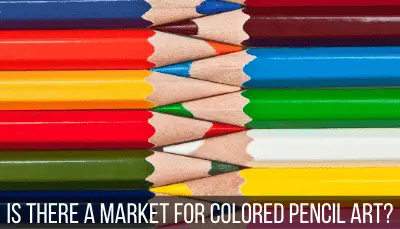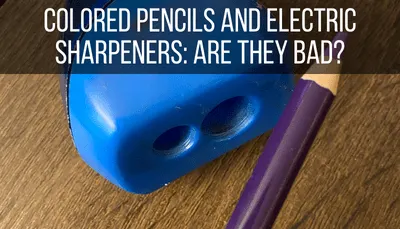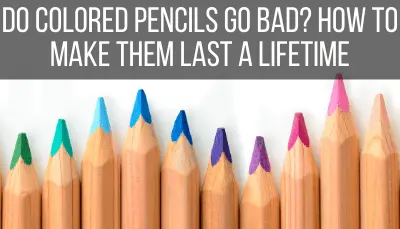Colored pencils and crayons are classic art mediums. We all have memories of both of them dating back to our youngest art years. In a lot of ways, they seem really similar, yet, they have some really important differences well. In the debate between colored pencils and crayons, which one wins? Which one is better?
Crayons are better than colored pencils if you’re looking for a waxy sheen to your art, while colored pencils are better than crayons for precision work. That said, it’s a complicated debate given the amount of resources and choices that colored pencils offer over colored pencils.
You may be surprised that there isn’t a cut and dry answer to the question of whether colored pencils or crayons are better. It seems like it would be cut and dry. In fact, there are a few factors we need to consider before we can declare a winner.
This post may contain affiliate links, which means I may earn a commission if you decide to purchase through my links.
How Crayons and Colored Pencils are Built
Crayons and colored pencils actually share a lot of the same ingredients. Both are made out of a combination of wax, pigment, binders, and extenders (source). The ratios of each ingredient differ though. Crayons tend to be a lot more soft and waxy, while colored pencils are more firm and have less wax in their cores.
Crayons and colored pencils are basically the same when you look at their ingredients alone. One isn’t better than the other.
Yes, there are differences in the quality of colored pencils and crayons that various BRANDS produce, but there isn’t any inherent reason why one would be better or worse than the other. Some companies make more expensive, high quality products, while others make cheaper, low quality products.
You might be assuming that I’m thinking about Crayola when I’m referring to low quality products. But, you’re wrong. Crayola actually makes really good crayons. In fact, professional artists have made some INCREDIBLE artwork using Crayola crayons. Keep reading because, in the next section, we’re talking about why Crayola and other crayon brands get such a bad rap when they really shouldn’t.
Crayons Have a Reputation
Most of us think of crayons as a go-to elementary school art supply that litters the rooms of every teacher we’ve ever had until high school. It’s great that crayons are often the first tool that every budding young artist uses, but that’s a problem too.
A lot of us don’t think beyond the elementary school classroom walls.
This means that we never TRY to use them seriously. We never think of them in a professional way. Instead, we assume that they’re kids play and we grab our colored pencils instead. Then, years later, on a random chance that we find ourselves babysitting a young child or spending time with a young family member, we pick up a crayon again and realize that our art skills just aren’t translating as well with them.
So, we assume that crayons are meant for school children, grab our colored pencils, and move on. But, this isn’t giving crayons a fair shot. As we’ll talk about next, they’re pretty complex.
Crayons are Hard to Use
Crayons are actually hard to use well. And, just like any other medium, we need to learn how they work, get familiar with their nuances, and understand when and where they work best in the context of our art projects.
Crayons are tricky as far as art mediums go. They’re soft, greasy, and leave a lot of white spaces. Honestly, crayons aren’t all that pretty when left to their own devices without an artist’s touch.
They require a bit of finesse…and practice. Colored pencils require some skill to use well, but it’s easier to fake it with colored pencils than it is with crayons. Colored pencils are smooth, crisp, and even. Despite having any art skills, colored pencils work pretty well, universally.
We take for granted the fact that we spend A LOT of time learning how to paint, draw, and watercolor. We take art classes; we spend time learning how to blend and wash; we make sure that we research the right supplies to buy. Well, we need to do the same with crayons.
Learning how to use crayons well takes the same amount of time and attention as it takes to learn any other type of art medium.
Get out of the elementary school mindset and start thinking about crayons as a professional tool to add to your artist’s toolkit. But, as we’ll talk about next, you’ll have to do a lot of self-experimentation and teaching as far as crayons are concerned.
Whether colored pencils or crayons are better definitely comes down to how much experience and skill you have with them.
Honestly, not a lot of people have a lot of experience with crayons and, given that they’re a tricky medium to learn, they can seem like the less favorable choice. As a new, beginning artist, I would choose colored pencils. Yes, there is some learning involved, but they will have a smaller learning curve than crayons.
There are More Choices for Colored Pencils Than Crayons
At risk of sounding like a broken record, let me say again that Crayola is a popular crayon brand, both with school children and with professional artists. In fact, can you even name any other crayon brands? Unless you’re a crayon aficionado, my guess is that nothing but Crayola comes to mind.
Spoiler alert, Caran d’Arche has a great line of high quality crayons they call Neocolor II Aquarelle Artists’ Crayons. Even the name is fancy! These are really nice crayons if you’re wanting something upscale and different than Crayola. But, broken record again, remember that a lot of professional artists use Crayola. That bright yellow box can be your friend throughout your entire artistic life. So, Caran d’Arche or Crayola – take your pick. But, there’s no denying that there are A LOT fewer choices of crayons than there are colored pencils.
When debating whether crayons or colored pencils are better, we have to realize that it isn’t always a fair fight. Colored pencils have so many more brands. They have countless fighters to put into the boxing ring, while crayons only have 2 predominant superstars.
As an artist, I like having choices. The fact that there are a wide variety of colored pencils to choose from does appeal to my love of shopping for art supplies. So, if you like having a wide variety of tools to choose from, colored pencils win the fight here.
There are Fewer Classes About Crayons Than Colored Pencils
You’ve probably never stumbled upon a professional crayon class. Heck, you wouldn’t be able to stumble upon one even if you tried. There are TONS of videos and blog posts about how to do crayon projects with kids, but not about using crayons as a legit artist (see, this is why crayons have the reputation that they do!).
My all-time favorite place to take classes that will develop my art skills is Skillshare. They have an AMAZING amount of classes on every topic from painting to drawing.
Yet, they don’t have any classes on crayons…they have an INSANE amount of classes and even they don’t have any classes about crayons. See, it’s hard to break the elementary school stigma and learn how to use crayons well when even one of the biggest art class platforms doesn’t even have any.
But, really, I LOVE Skillshare. If you’re on the colored pencil bandwagon, go check out their colored pencil classes. They’re phenomenal.
Colored Pencils vs. Crayons: What’s the Verdict?
At the end of the day, colored pencils and crayons are different. Yes, they share similarities in their ingredients and colors, but they are fundamentally different art mediums.
It’s like comparing a lemon and a lime. One is better than the other depending on the context. A lime is better for key lime pie, but a lemon will be the winner when making lemonade. Crayons and colored pencils are the same way. Looking for a waxy shine? Go with crayons? Need a precise tool to fill in small nooks and crannies? Go with colored pencils.
Both crayons and colored pencils can be really useful and valuable tools in your artist’s toolkit. Once you learn how to use both of them effectively, you can see what they’re pros and cons are and decide which you prefer given your own art needs.

Diana has been an artist for over 27 years and has training in drawing, painting, digital drawing and graphic design. Diana’s latest obsession is digitally drawing with Procreate and Procreate Dreams. Diana has experience selling her art across a number of platforms and loves helping other artists learn how to make money from their art as well.






